










_planets.jpg)
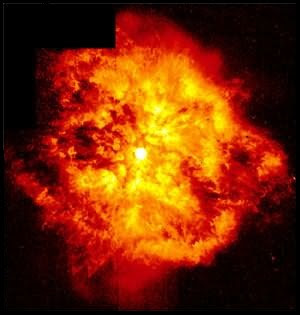
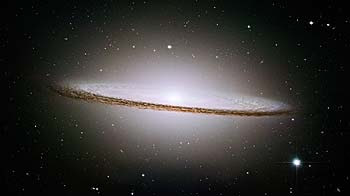 galaxy exploded into view as the supernova closest to Earth in 400 years. The outburst was labeled Supernova 1987a.
galaxy exploded into view as the supernova closest to Earth in 400 years. The outburst was labeled Supernova 1987a.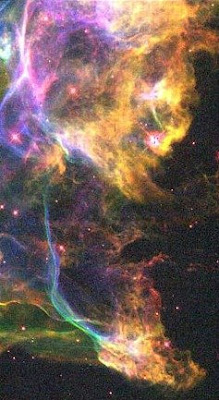
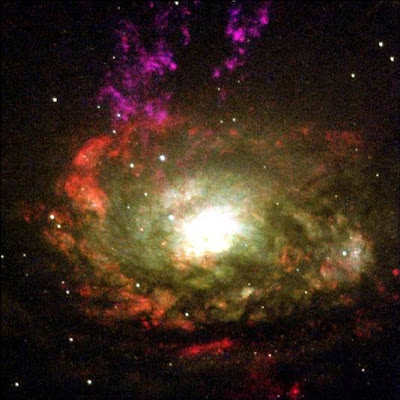 xies or the cores of very active galaxies.
xies or the cores of very active galaxies.
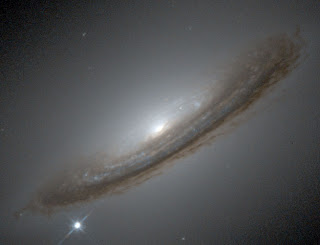
Saat dua galaksi bergabung, lubang hitam supermasif yang ada di kedua galaksi itu tentu akan berinteraksi. Bisa saja interaksi tersebut melalui sebuah tabrakan, atau mungkin dari gerak spiral ke dalam sampai mereka mengalami penyatuan (merger). Menarik bukan?
Berdasarkan simulasi yang dilakukan G. A Shields dari University of Texas, Austin dan E. W. Banning dari Yale University, hasil penyatuan tersebut seringnya merupakan gerakan mundur yang sangat kuat. Dalam proses penggabungan ini, lubang hitam tersebut bukannya mengalami proses penggabungan yang manis, namun gaya yang muncul sangat ekstrim sehingga salah satu lubang hitam akan terdorong keluar dengan kecepatan yang sangat besar.
Dorongan maksimum terjadi pada kedua lubang hitam saat mereka berputar dengan arah yang berbeda, namun keduanya berada pada bidang orbit yang sama. Dalam fraksi hanya satu detik, satu lubang hitam sudah mendapat dorongan yang cukup untuk keluar dari galaksi yang baru saja bersatu dan tak pernah kembali lagi. Saat satu lubang hitam mengalami dorongan, yang lainnya akan menerima energi yang amat besar, terinjeksi ke dalam piringan gas dan debu disekitarnya. Piringan akresi akan bersinar dengan flare sinar X tipis dan baru akan berakhir beberapa ribu tahun.
Nah, meskipun kejadian merger atau penggabungan lubang hitam supermaif itu sangat jarang, kecerlangan yang ditimbulkannya akan berakhir dalam waktu yang cukup lama sehingga bisa kita deteksi sejumlah kejadian yang pernah terjadi. Menurut para peneliti, ada sekitar 100 gerakan mundur yang tiba-tiba yang terjadi dalam 5 miliar tahun cahaya dari Bumi.

 us A dan B mengelilingi titik pusat gravitasi mereka yang sama adalah 49,9 tahun. Angka ilmiah ini kini diterima secara bulat oleh jurusan astronomi di universitas Harvard, Ottawa dan Leicester.2 Keterangan ini dilaporkan dalam berbagai sumber sebagai berikut:
us A dan B mengelilingi titik pusat gravitasi mereka yang sama adalah 49,9 tahun. Angka ilmiah ini kini diterima secara bulat oleh jurusan astronomi di universitas Harvard, Ottawa dan Leicester.2 Keterangan ini dilaporkan dalam berbagai sumber sebagai berikut: This image shows the striking Maunder crater located in the region of Noachis Terra on Mars. The High Resolution Stereo Camera (HRSC) on ESA’s Mars Express took pictures of this region on November 29 and December 14, 2005. Named after British astronomer Edward W. Maunder, the crater is located halfway between Argyre Planitia and Hellas Planitia on the southern Highlands of Mars. With a diameter of 90 kilometres and a depth of nearly 900 metres, the crater is not one of the largest impact craters on Mars, but it was much deeper in the past. It has since been filled partially with large amounts of material. The perspective view shown here has been calculated from the digital terrain model derived from the camera’s stereo channels.
This image shows the striking Maunder crater located in the region of Noachis Terra on Mars. The High Resolution Stereo Camera (HRSC) on ESA’s Mars Express took pictures of this region on November 29 and December 14, 2005. Named after British astronomer Edward W. Maunder, the crater is located halfway between Argyre Planitia and Hellas Planitia on the southern Highlands of Mars. With a diameter of 90 kilometres and a depth of nearly 900 metres, the crater is not one of the largest impact craters on Mars, but it was much deeper in the past. It has since been filled partially with large amounts of material. The perspective view shown here has been calculated from the digital terrain model derived from the camera’s stereo channels.

Transits of Venus are possible because the planet's orbit around the Sun is inside that of Earth. Venus Transits occur in pairs, with the second coming eight years after the first. But the pair events are separated by either 105.5 or 121.5 years.
Venus is the only planet in the Solar System to turn in a clockwise direction on its axis, and it does this very slowly, taking 243 Earth days to do so. The "day" on Venus is even longer than a year on Venus, which is 225 Earth days long. Venus is covered in poisonous clouds containing sulphuric acid, and an atmosphere containing dangerous carbon monoxide.
In 1990-1994 the special imaging equipment on the Magellan space craft managed to look through the clouds to reveal a volcanic surface of the planet. Temperatures on Venus reach up to 480°C because heat from the Sun cannot escape through the thick atmosphere, which acts like a greenhouse covering the entire planet.
Jeremiah Horrocks used his observations to estimate the distance between the Earth and the Sun - his calculation of 59,000,000 miles was far from the true number but much closer than any previous numbers. Still in the 17th century Rev. James Gregory and Sir Edmund Halley suggested that a more accurate measurement of the Earth-Sun distance could be made using the Transit of Venus from different places. In 1761 and 1769 the distance was computed to 93,000,000 miles. The photographs taken in 1882 were used in the following years to difficult but more detailed calculations of the Sun-Earth distance to 92,702,000 miles (Simon Newcomb), resp. 92,797,000 (William Harkness). The Transit of 2004 can be used for getting more precise number.
Long time ago in Egypt scientists tried to work out distances in space by measuring shadows in different places. Similar methods are used today. During the Transit Venus enters the Sun's disc in various times according to the position of the observer. Comparison of these times makes it possible to calculate the distance from the Earth to the Sun.
 One of the most identifiable nebulae in the sky, the Horsehead Nebula in Orion, is part of a large, dark, molecular cloud. Also known as Barnard 33, the unusual shape was first discovered on a photographic plate in the late 1800s. The red glow originates from hydrogen gas predominantly behind the nebula, ionized by the nearby bright star Sigma Orionis. A blue reflection nebula surrounds the bright star at the lower left. The darkness of the Horsehead is caused mostly by thick dust, although the lower part of the Horsehead's neck casts a shadow to the left. Streams of gas leaving the nebula are funneled by a strong magnetic field. Bright spots in the Horsehead Nebula's base are young stars just in the process of forming. Light takes about 1500 years to reach us from the Horsehead Nebula. The above image was taken earlier this month with a 0.6-meter telescope at the Mt. Lemmon SkyCenter in Arizona, USA.
One of the most identifiable nebulae in the sky, the Horsehead Nebula in Orion, is part of a large, dark, molecular cloud. Also known as Barnard 33, the unusual shape was first discovered on a photographic plate in the late 1800s. The red glow originates from hydrogen gas predominantly behind the nebula, ionized by the nearby bright star Sigma Orionis. A blue reflection nebula surrounds the bright star at the lower left. The darkness of the Horsehead is caused mostly by thick dust, although the lower part of the Horsehead's neck casts a shadow to the left. Streams of gas leaving the nebula are funneled by a strong magnetic field. Bright spots in the Horsehead Nebula's base are young stars just in the process of forming. Light takes about 1500 years to reach us from the Horsehead Nebula. The above image was taken earlier this month with a 0.6-meter telescope at the Mt. Lemmon SkyCenter in Arizona, USA.